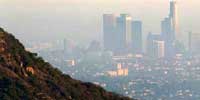Sep 29 2008
Existing regulations may not effectively target a large source of fine, organic particle pollutants that contribute to hazy skies and poor air quality over Los Angeles, according to a study scheduled for the October 15 issue of ACS' Environmental Science and Technology, a semi-monthly journal.
 Smog above Los Angeles, as seen from the Hollywood Hills
Smog above Los Angeles, as seen from the Hollywood Hills
In the study, Ken Docherty and colleagues point out that current air quality regulations target sources of 'primary,' or directly emitted, particles. Yet their new findings indicate that "secondary" or chemically formed, particles contribute more significantly to poor air quality.
The study found that most of the organic haze above the city is not directly emitted by vehicles or industrial processes, unlike previously thought — 75 percent of organic particle pollutants form when reactive, organic gases undergo chemical transformations and condense onto existing particles in the air. "Our study suggests that regulations need to focus much more attention on the organic gases that react chemically in the atmosphere, creating the secondary particles that make up a significant portion of haze," Docherty said.